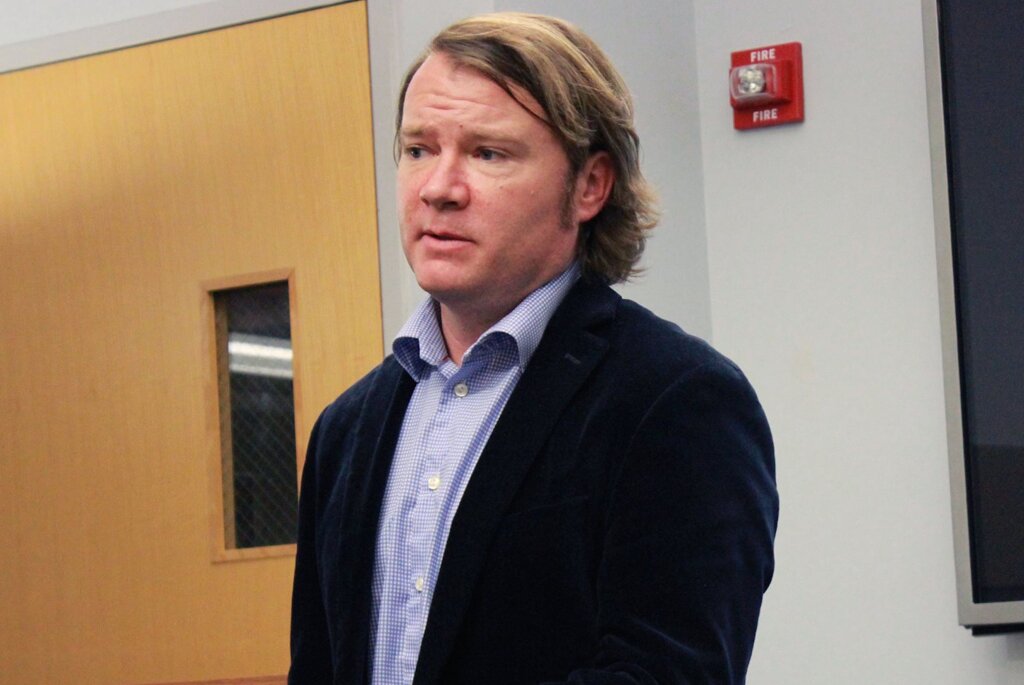Watch the video of the event here
On Wednesday, March 9, 2016, the NYU Jordan Center for the Advanced Study of Russia welcomed Robert Crews, Associate Professor of History and Director of the Abbasi Program in Islamic Studies at Stanford University for a book talk devoted to his recent book, Afghan Modern: The History of a Global Nation. The event focused on Afghan encounters with Russia, the USSR, and Central Asia and explored Afghanistan’s engagement with the global circulation of modern politics.
“Robert Crews made his name very early on by writing a book on Islam in Imperial Russia, and put forward the proposition that Islam was actually intrinsic to imperial governance as opposed to outside of imperial governance or as opposed to outside of the imperial system as a whole, which is quite an eye-opener,” NYU Jordan Center Director Yanni Kotsonis said in his introduction. “He actually transformed the way we understand religion, Islam and diversity in the Russian Empire.”
Crews started his talk by explaining how the idea for his new book came about. “The lens of war and [American] failures have really dominated our thinking and certainly our scholarship about Afghanistan,” he said highlighting a particular bias in the works on Afghan history published since 2001. In particular, Crews noted the recurring presence of tropes portraying the country as an empty, forbidding and dangerous landscape threatening to civilization. “If one looks at book covers that adorn books on Afghanistan for the last twenty years they all have the same quality,” he said. “It’s almost as if one book designer recycled the same image.”
Crews said that distorted images have been used to validate a narrative of salvation that justifies the use of violence and to attribute the failures of the U.S. policy since 2001 to the region’s unredeemable nature. “I try to argue that all these images are inaccurate, they are unfair, they are unjust, and maybe they are in fact also racist and Islamophobic,” he added.
In response to this, he felt compelled to suggest an alternative mode of thinking that would convey elements of urbanism, modernity, commerce, and leisure in Afghanistan. Crews drew a global history of the country, placing it in a context of global connectivity often propelled by the trade of key commodities such as guns, cannabis, opium and poetry. He also placed emphasis on the physical mobility of the Afghan community, highlighting the presence of Afghan traders, poets, seafarers and entrepreneurs in the likes of India, Iraq, Australia and California. “I treat Afghanistan as an expansive space that accommodated various kinds of networks that crisscrossed the region and the globe,” he explained.
A large part of Crews’ research was devoted to the role of Afghan intellectuals. “They are not just people who come to terms with modernity as defined by someone else,” he said. “They think that their answers are universal and they think that their country is fated to answer the pressing questions of the day.” The development of various cosmopolitanisms – commercial, diplomatic, religious, literary and artistic – enabled the scholar to explore the dynamism inherent the Afghan historical journey.
Zooming in on the relationship between Russia and Afghanistan, Crews drew attention to another sphere of dynamism in the Russian frontier. “We see people moving back and forth, playing states off against one another,” he said. This caused the proliferation of the image of Afghanistan as a refuge for Russian deserters escaping tsarism, while also convincing Russia of its role as a civilizing force in the region as the empire welcomed more and more Afghan émigrés. Aside from illustrious exiles such as the former Emir of Afghanistan Abdur Rahman, Crews pointed to an Afghan presence in then-Russian sites, such as Samarkand, Tashkent and Bukhara. The meeting between Afghan and Russian civilization became even more significant after Amanullah Khan declared independence from Britain in 1919. This posed a direct threat to the newly established Soviet state, but did not prevent the Bolsheviks from looking to Kabul as as a vector to export the revolution to South Asia and the British Empire.
Meanwhile, Afghan intellectuals continued to develop narratives displaying a globally oriented mindset, Crews noted. As Afghanistan continued to be a refuge for radical forces from India, they put forward the idea of the country as a center of action and alternative to the inhumanity of empires around the world. One of the most prominent representatives of this trend was Raja Mahendra Pratap Singh, who advocated for Afghanistan to make common cause with India, Persia, Turkey to save Asia from the faith of colonial subjugation endured by Africa.
Despite such lines of thinking, Crews noted how in the 1950s and even in the 1960s Afghanistan found itself as a contested territory between two superpowers. “The Americans and Soviets were treating Afghanistan as a center piece of this global Cold War struggle,” he said. Still, the scholar pointed out how this race could at times play to Afghanistan’s advantage, as both sides started directing millions of dollars into developing Afghan infrastructures and promoting educational programs.
Crews pointed out that Soviet-era interactions with the outer world also stimulated intellectual discourses within the country. For example, Maxim Gorky’s work was credited with starting discussions over the importance of social realism in the portrayal of poverty among Afghan rural communities. Conversely, Afghans belonging to leftist circles would often problematize their relationship with the United States and the Soviet Union, particularly in the context of the Soviet–Afghan War and its aftermath. Crews also drew attention to the interplay between the Afghan gaze and the collapse of the Soviet Union. “It is a moment of euphoria, for not just Afghan jihadists but for the global scene,” he said. “They imagine that they have caused this to happen and for some of them the next step is to take this back to places like Libya, Jordan, to Palestine, to Syria and to have their own revolutions there.”
In the ensuing Q&A session Kotsonis praised Crews for his use of images of movement, and asked him to expand on the issue of intellectual mobility. In response, Crews spoke about the importance of the diaspora in facilitating the exchange of ideas. NYU Professor of Russian and Slavic Studies Rossen Djagalov inquired about the porousness of the borders between the Soviet Union and Afghanistan. Crews replied that while physical movement became more difficult after 1930s, a consistent exchange between the two continued to exist as Afghan leftist groups tested the grounds of their own ideology looking to Moscow and Beijing. Other questions touched upon the efforts in Afghan political thought to define notions of an Afghan state, as well as the divergence between the agenda of Afghan women in a contemporary context and the images projected on them by their would-be protectors in the West.



